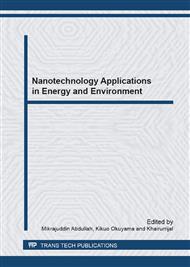[1]
M.I. Nugraha, A.S. Aji, Yudhistira, F. Rahayu, Y. Darma, Quantum Size Effect Simulation on the Electrical Characteristic of Single Electron Transistor, AIP Conf. Proc. 1415 (2011) 98-101.
DOI: 10.1063/1.3667230
Google Scholar
[2]
S. Hong, Y. Chang, I. Rhee, Chitosan-coated Ferrite (Fe3O4) Nanoparticles as a T2 Contrast Agent for Magnetic Resonance Imaging, J. Korean Phys. Soc. 56 (2010) 868-873.
DOI: 10.3938/jkps.56.868
Google Scholar
[3]
Y.M. Wang, X. Cao, G.H. Liu, R.Y. Hong, Y.M. Chen, X.F. Chen, H.Z. Li, B. Xu, D.G. Wei, Synthesis of Fe3O4 magnetic fluid used for magnetic resonance imaging and hyperthermia, J. Magn. Magn. Mater. 323 (2011) 2953-2959.
DOI: 10.1016/j.jmmm.2011.05.060
Google Scholar
[4]
A. Nielsen, A. Brandlmaier, M. Althammer, W. Kaiser, M. Opel, J. Simon, W. Mader, S.T.B. Goennenwein, R. Gross, All oxide ferromagnet/semiconductor epitaxial heterostructures, Appl. Phys. Lett. 93 (2008) 162510.
DOI: 10.1063/1.2998576
Google Scholar
[5]
J. Neamtu, N. Verga, Magnetic nanoparticles imaging for magneto-resonance and targeted drug delivery, J. Nanomater. Biostruct. 6 (2011) 969-978.
Google Scholar
[6]
W. Jiang, H.C. Yang, S.Y. Yang, H.E. Horng, J.C. Hung, Y.C. Chen, C-Y. Hong, Preparation and properties of superparamagnetic nanoparticles with narrow size distribution and biocompatible, J. Magn. Magn. Mater. 283 (2004) 210-214.
DOI: 10.1016/j.jmmm.2004.05.022
Google Scholar
[7]
J. Sun, S. Zhou, P. Hou, Y. Yang, J. Weng, X. Li, M. Li, Synthesis and Characterization of Biocompatible Fe3O4 Nanoparticles, J. Biomedical Mater. Res. Part A (2006) 333-341.
DOI: 10.1002/jbm.a.30909
Google Scholar
[8]
Y. Sun, L. Duan, Z. Guo, Y.D. Mu, M. Ma, L. Xu, Y. Zhang, N. Gu, An improved way to prepare superparamagnetic magnetite-silica core-shell nanoparticles for possible biological application, J. Magn. Magn. Mater 285 (2005) 65-70.
DOI: 10.1016/j.jmmm.2004.07.016
Google Scholar
[9]
N.N. Nassar, A. Hassan, P. Pereira-Almao, Metal Oxide Nanoparticles for Asphaltene Adsorption and Oxidation, Energy Fuels 25 (2011) 1017-1023.
DOI: 10.1021/ef101230g
Google Scholar
[10]
L. Wei, Z. Jian-Hua, Q. Jian-Hua, Application of Nano-Nickel Catalyst in the Viscosity Reduction of Liaohe Extra-Heavy Oil by Aquathermolysis, J. Fuel Chem. Technol. 35 (2007) 176-180.
DOI: 10.1016/s1872-5813(07)60016-4
Google Scholar
[11]
S.K. Maity, J. Ancheyta, G. Marroquin, Catalytic Aquathermolysis Used for Viscosity Reduction of Heavy Crude Oil: A Review, Energy Fuels 24 (2010) 2809-2816.
DOI: 10.1021/ef100230k
Google Scholar
[12]
Y. Liu, H. Fan, The Effect of Hydrogen Donor Additive on the Viscosity of Heavy Oil during Steam Stimulation, Energy Fuels 16 (2002) 842-846.
DOI: 10.1021/ef010247x
Google Scholar
[13]
M. Stjerndahl, M. Andersson, H.E. Hall, D.M. Pajerowski, M.W. Meisel, R.S. Duran, Superparamagnetic Fe3O4/SiO2 Nanocomposites: Enabling the Tuning of Both the Iron Oxide Load and the Size of Nanoparticles, Langmuir. 24 (2008) 3532-3536.
DOI: 10.1021/la7035604
Google Scholar
[14]
T. Koutzarova, S. Kolev, S., Ch. Ghelev, D. Paneva, I. Nedkov, Microstructural study and size control of iron oxide nanoparticles produced by microemulsion technique, Physica Status Solidi (c) 3 (2006) 1302-1307.
DOI: 10.1002/pssc.200563115
Google Scholar
[15]
L.T. Chao, M. Wei, J.L. Macmanus-Driscoll, Synthesis and characterization of nanocrystalline iron oxides via ultrasonic spray assisted chemical vapour deposition, J. Phys. Conf. Series 26 (2006) 304-307.
DOI: 10.1088/1742-6596/26/1/073
Google Scholar
[16]
A. Lagashetty, V. Havanoor, S. Basavaraja, S.D. Balaji, A. Venkataraman, Microwave-assisted route for synthesis of nanosized metal oxides, Sci. Technol. Adv. Mater. 8 (2007) 484-493.
DOI: 10.1016/j.stam.2007.07.001
Google Scholar
[17]
Y. Jeanvoine, R. Spezia, Mn2+-, Fe2+-, Co2+-, Ni2+-, Cu2+-, and Zn2+- binding chalcogen-chalcogen bridges: a compared MP2 and B3LYP study, J. Phys. Chem. A 113 (2009) 7979-87.
DOI: 10.1021/jp811460f
Google Scholar


